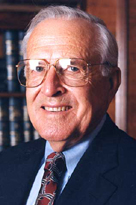Robert E. Johnson, director of the CRS
Center at Texas A&M University, was recently appointed to the
Thomas A. Bullock Endowed Chair in Leadership and Innovation at
the College of Architecture.
The position, which honors Thomas A. Bullock, former chairman and partner of the influential architectural firm Caudill Rowlett and Scott (CRS), is awarded to an individual who has demonstrated insight, originality and extraordinary management skills in the design and construction industry.
“As a scholar, teacher and astute practitioner of the design and construction industry’s best practices, Dr. Johnson has been a valuable mentor to students and professionals alike,” said J. Thomas Regan, dean of the College of Architecture. “His appointment to the Thomas A. Bullock Chair in Leadership and Innovation will further enable his efforts to advance leadership and management practices.”
Johnson, a registered architect and member of the American Institute of Architects (AIA), joined the architecture faculty at Texas A&M in 1995 and was appointed director of the CRS Center for Leadership and Management in the Design and Construction Industry in 1996.
The CRS Center, named after the architecture, engineering and planning firm CRS, was established at Texas A&M University in 1990 to advance innovation and leadership in the design and construction industry. The center houses the archives of CRS and its successor CRSS (Caudill Rowlett Scott and Sirrine) and administers the College’s Facility Management Certificate Program.
“The CRS Center is a bridge between the profession and the students,” Johnson said. “Through the center’s resources, students can develop an understanding of professional architectural practice.”
Bullock, the chair’s namesake, graduated with an architecture degree from Texas A&M in 1949. Bullock joined CRS in 1948 while still enrolled as an undergraduate at Texas A&M University. He became the firm’s fifth partner in 1954 and served his entire professional career at CRS. For forty years Bullock was the leading management voice in CRS. He served as managing partner/president in 1957 until the firm went public in 1971, after which he was board chairman until his retirement in 1989. He held his position as chairman of the CRSS Executive Committee until 1995. Widely recognized as a leader in the architecture profession, he was named an AIA Fellow in 1970, received the Llewelyn Pitts Award from the Texas Society of Architects in 1976 and in 1998 was named an Outstanding Alumnus of the Texas A&M College of Architecture.
Bullock’s personal records, including correspondences, published articles, photographs and even audio and video tapes, are part of the 47-year history of CRS archived at the CRS Center. The center is currently in the process of digitizing their archives and making them available on line, a project implemented by Johnson.
Before coming to Texas A&M, Johnson was a member of the architecture faculty at the University of Michigan, where he served in various administrative positions from 1989 to 1995. Johnson holds a doctoral degree in architecture from the University of Michigan. He completed his master’s and bachelor’s degrees in architecture at Syracuse University and earned a bachelor’s of art in economics from Colgate University.
Johnson has taught design studio, theories of architectural research, building economics, information technology and architectural management. His current research concentrates on the impact of information and communication technologies on the design and construction industry. He has written numerous academic and professional papers as well as a book, “The Economics of Building,” published by Wiley in 1990.
In the classroom Johnson employs a “student-centered, active learning process” and he strives to “develop students’ appreciation for the difficulties of applying textbook theories to everyday practice.”
Johnson finds particular value in teaching courses that explore the organizational and management practices of professional design and construction firms. “Many students think a firm that designs great projects is a great firm to work for,” Johnson commented, “but that is not necessarily true. I try to provide a framework for students to understand the variety of firms that exist and help them develop an understanding of their unique personal strengths and weaknesses so they can determine what type of firm will better fit their professional goals.”
| |
 Robert E. Johnson
Robert E. Johnson
 Thomas A. Bullock
Thomas A. Bullock
|